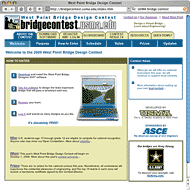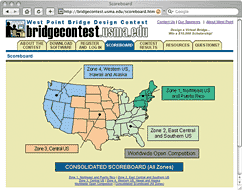Overseas News on Civil Engineering IT
|
|
This section focuses on a unique overseas website related to civil engineering IT. This issue features "West Point Bridge Design Contest", offered by the U. S. Military Academy at West Point (USMA) through providing bridge design software online for American students learning at middle schools, high schools, or their equivalents.
Engineering Education Offered for Over 200 Years Since its Foundation
Located approximately 50 miles north of New York City on the west bank of the Hudson River, the United States Military Academy (USMA) is a four-year academy well known by the name of West Point. Since its foundation in 1802, the Academy has accomplished its mission by developing cadets in four critical areas: intellectual, physical, military, and moral-ethical. Upon graduation, all cadets are awarded Bachelor of Science degrees, and at the same time commissioned to serve in the U.S. Army at least five years. West Point graduates have been actively involved in a variety of fields of life. Some of them have served as engineers.
According to the website, USMA was the first school in the U.S. to offer a formal program of education in engineering. During the first half of the 19th century, civil engineering was the base of the Academy's curriculum. Academy graduates of those years designed and built many of the nation's railroads, bridges, harbors, and roads.
Bridge Design Contest to Provide Young Students with an Introduction to Engineering
"West Point Bridge Design Contest" is held for students corresponding to middle school and high school students. Using software provided online, participants design a truss bridge, improve their designs by submitting them and receiving automatic feedback, and compete for the final places.
The purpose of the contest is to provide young students with a realistic, engaging introduction to engineering, as well as to commemorate West Point's engineering heritage and its role in developing the nation's infrastructure. The goals of the contest are to offer an opportunity to: 1) Learn about engineering through a realistic, hands-on problem-solving experience. 2) Learn about the engineering design process--the application of math, science, and technology to create devices and systems that meet human needs. 3) Learn about truss bridges and how they work. 4) Learn how engineers use the computer as a problem-solving tool.
The contest is funded by private donations. One of its principal sponsors is the American Society of Civil Engineers (ASCE), which was covered in this article series in an earlier issue. There is no fee for entering the contest. The 2009 Contest has begun on October 2008 and will end on June 2009 (the on-line registration and automated judging system will remain operational until July 1). Its period is adjusted with the school semesters from fall to spring.
Eligible contestants include: 1) students, age 13 through grade 12, who are currently enrolled in middle schools, junior high schools, and high schools in the United States, 2) students, age 13 through grade 12, who are legally home schooled in the United States, and 3) all U.S. citizens, age 13 through grade 12, who are attending school or home-schooled outside of the United States. Students may register individually or in teams of two members, but competing in teams is strongly recommended because teams are expected to perform better than individuals.
Each contestant team is supposed to download and install the West Point Bridge Designer 2007 software for free from the website, and design a truss bridge. Then the team saves the design as a "bridge design file", and registers for the contest through the website. Registration is made by zone, and it is possible to simultaneously register for a local contest, which is run all year long. After that, uploading the design file, the team will receive immediate feedback about its current standing in the contest. The website says that basically lower cost results in higher standing if the design is valid.
Based on the feedback, the team uses the software again to improve the design, log in to the website, and submit the improved design. There is no limit to how many designs one team may submit; however, only the team's best design will be included in the contest standings. Instant feedback on the team's standing will be returned, and if the score is in the current top 30 for its contest zone, the team name and school will be posted on the contest scoreboard on the website. At the end of the contest, the top ten teams from each zone will receive a certificate, signed by the Contest Director.
Software Provision, Submission of Designs, Judgment, Improvement, and Standings Are All Managed on the Website
Besides the above-mentioned outline of the contest, this website provides Tutorial for using the software, through which one can input data such as for abutments or piers according to the instruction of the screen, and learn the process of designing a truss bridge. "SCOREBOARD" shows a color-coded map of domestic 4 zones (Northeast US and Puerto Rico; East Central and Southern US; Central US; and Western US, Hawaii and Alaska), Worldwide Open Competition, and Consolidated Scoreboard for all zones. Clicking the map, one can view the page for standings in the corresponding zone. It might be possible to say that "home school" found here and there in the columns to indicate contestants' schools may be characteristic of the U.S., where home schooling is legally admitted. In addition, since there is no restriction on the number of teams from any given school, some cases imply a school-wide challenge. There is also no restriction on collaboration during the contest, so getting help from friends does not mean breaking any rules. Rather, it suggests that the contest intends to promote such learning activities.
"CONTEST RESULTS" shows the winning teams, their designs, and photos of final rounds in the previous years. According to the site, over 750 designs were submitted at the Semifinal Round of the 2006 Contest. Originally there were national final rounds with prizes, e.g. scholarships for the top teams. However, those final rounds and prizes were discontinued because of difficulties in resources and operation. The website expresses the motivation to participate as "Designing bridges is an intrinsically rewarding experience. Learning about engineering is challenging and fun." The current contest also has a role to support local contests run by teachers and others in their local communities.
 |
 |
|
West Point Bridge Design Contest |
and for all zones consolidated From http://bridgecontest.usma.edu/scoreboard.htm |
|
| (Images provided by USMA) | ||
This article is written based on the above website with permission from USMA.
 |
 |
 |
||
| BACK | LIST | NEXT |